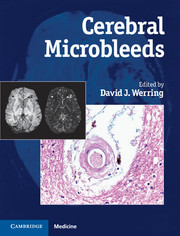Book contents
- Cerebral Microbleeds
- Cerebral Microbleeds
- Copyright page
- Contents
- Contributors
- Foreword
- Preface
- Terminology
- Section 1 Historical aspects, detection and interpretation
- Chapter 1 Historicaloverview
- Chapter 2 Detectionof cerebral microbleeds
- Chapter 3 Susceptibility-weightedimaging
- Chapter 4 Definingand mapping cerebral microbleeds
- Chapter 5 Cerebral microbleedmimics
- Section 2 Mechanisms underlying microbleeds
- Section 3 Microbleeds in relation to specific populations, diseases and neurological symptoms
- Index
Chapter 3 - Susceptibility-weightedimaging
from Section 1 - Historical aspects, detection and interpretation
Published online by Cambridge University Press: 05 July 2011
- Cerebral Microbleeds
- Cerebral Microbleeds
- Copyright page
- Contents
- Contributors
- Foreword
- Preface
- Terminology
- Section 1 Historical aspects, detection and interpretation
- Chapter 1 Historicaloverview
- Chapter 2 Detectionof cerebral microbleeds
- Chapter 3 Susceptibility-weightedimaging
- Chapter 4 Definingand mapping cerebral microbleeds
- Chapter 5 Cerebral microbleedmimics
- Section 2 Mechanisms underlying microbleeds
- Section 3 Microbleeds in relation to specific populations, diseases and neurological symptoms
- Index
Summary
- Type
- Chapter
- Information
- Cerebral MicrobleedsPathophysiology to Clinical Practice, pp. 22 - 33Publisher: Cambridge University PressPrint publication year: 2011
- 3
- Cited by



